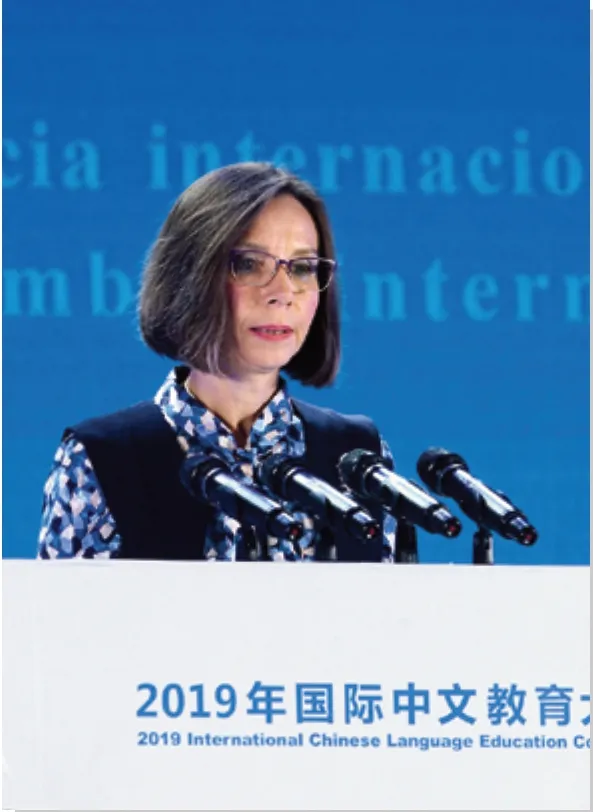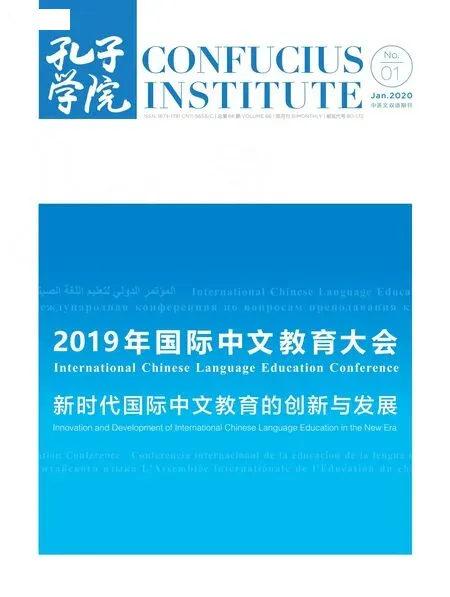白罗米
罗马尼亚布加勒斯特大学中文系主任

我很荣幸应汉办的邀请在今年的国际中文教育大会开幕式上发言。首先要感谢汉办给我提供这样一个机会与各位分享罗马尼亚的汉语教学现状。
罗马尼亚汉语教学有着悠久的历史。1960 年布加勒斯特大学成立了汉语专业。布大汉语言专业有硕士点和博士点。目前,罗马尼亚有6 所大学开设了汉语言学专业。每年招收汉语专业的本科生近200 人,硕士近10人,2019年在读的博士生一共6人。
孔子学院有力地促进了当地高校汉语言专业的设立。除了布加勒斯特大学中文专业外,另外三所孔院的外方合作院校都是在孔院建立之后,在孔院的积极推动下成立了汉语言专业。孔子学院在推动罗马尼亚汉语教学方面发挥着举足轻重的作用。2007 年由北京语言大学和锡比乌卢奇安·布拉卡大学合作建立了罗马尼亚第一所孔子学院。此后,罗马尼亚相继建立了克卢日巴比什·波雅依大学孔子学院、布拉索夫特兰西瓦尼亚大学孔子学院和布加勒斯特大学孔子学院。目前,罗马尼亚共有4 所孔子学院,1 个独立孔子课堂和10 所孔院下属孔子课堂。另外,各孔院又在周边城市下设一些中小学汉语教学点,共计近100 个,分布在罗马尼亚12 个大中小城市。
2016 年6 月25 日,罗马尼亚教育部批准了布大孔院的申请,正式发文确认汉语列入中小学最新外语语言课程名单,这标志着汉语正式进入罗国民教育体系,罗中小学汉语教学迎来了新的里程碑。学生在高考时,可以选择汉语作为外语考试科目。在罗马尼亚教育体系中,汉语可以作为正式和非正式两种教育形式存在。非正式的教育形式就是指孔子学院系统的汉语教学,正式教育形式指的是学生从五年级开始把汉语作为第二外语学习,或者汉语作为学校同一课程的主要部分。
尽管罗马尼亚的汉语教学取得了很大成绩,但是,仍然面临许多现实的困难。其中最大的苦难是到目前为止还没有一本适合罗马尼亚学生学习的本土汉语教材。在汉语进入罗马尼亚国民教育体系之后,罗教育部成立了《罗马尼亚中小学汉语教学大纲》编写组,完成了罗马尼亚教育部认可的、和欧洲语言框架相对应的教学大纲。自此,以正式教育形式进行汉语教学的中小学越来越多,统一使用罗马尼亚中小学汉语教学大纲。
但是,由于种种现实的困难,至今还没有一本本土汉语教材。这个问题极大地阻碍了当地的汉语教学。另外一个主要困难是,由于罗马尼亚公立学校教师编制有限,学校如果招聘本土汉语教师的话,极有可能面临学习汉语的学生人少,教师工作量不满的情况。因此,大部分的学校目前还不愿意招聘专职的本土汉语教师。这极大地束缚了汉语教学的推广。
以上是罗马尼亚的汉语教学现状。
回头看看,罗马尼亚的汉语教学硕果累累;展望未来,任重道远。
Luminita Balan
Director of the Department of Chinese Language and Culture of the University of Bucharest, Romania
It is a great honor for me to speak at the opening ceremony of the International Chinese Language Education Conference (ICLEC) upon the invitation of Hanban. First of all, I would like to thank Hanban for giving me this opportunity to share with you the status quo of Chinese language teaching in Romania.
Chinese teaching has a long history in Romania. In 1960, the University of Bucharest established a Chinese major. The Chinese major of the University of Bucharest offers both M.A. and Ph.D. programs. Currently, six Romanian universities have established Chinese major, with an annual enrollment of nearly 200 undergraduates and ten graduates. In 2019, there are six Ph.D.students in this major.
The Confucius Institute has greatly bolstered the setting up of Chinese major in Romanian higher education institutes. Except for the University of Bucharest, the Chinese major of the other three universities were set up after the founding of Confucius Institutes and actively promoted by them.The Confucius Institute plays a pivotal role in promoting Chinese teaching in Romania. In 2007, the first Confucius Institute in Romania was established in cooperation with Beijing Language and Culture University and Lucian Blaga University of Sibiu. Since then,Romania has successively established the Confucius Institute at Babes-Bolyai University, the Confucius Institute at Transilvania University of Brașov, and the Confucius Institute at the University of Bucharest. At present, there are 4 Confucius Institutes in Romania, 1 independent Confucius Classroom and 10 Confucius Classrooms. In addition, the Confucius Institutes also set up nearly 100 Chinese teaching sites in primary and secondary schools in surrounding cities, which are located at 12 Romanian cities.
On June 25, 2016, the Ministry of Education and Scientific Research of Romania (MESR) approved the application of the Confucius Institute at the University of Bucharest and officially issued confirmation to incorporate Chinese into the latest list of foreign language courses in primary and secondary schools. This marks the official entering of Chinese language into Romania’s national education system and a new milestone in the development of Chinese teaching in primary and secondary schools in the country. Students can choose Chinese as the foreign language test subject in their college entrance exams. In the education system in Romania, Chinese language serves as both formal and informal education.Informal education refers to the Chinese teaching in the Confucius Institute.Formal education means that students start to learn Chinese as a second foreign language from the fifth grade or take Chinese as the main part of school curriculum.
Despite the enormous progress in Chinese teaching in Romania, we are still faced with many difficulties. The biggest one is that by far, there is not yet a local Chinese textbook suitable for Romanian students. After the official incorporation of Chinese into the Romania’s national education system, the MESR of Romania established the compiling committee of Chinese Language Syllabus in Primary and Secondary Schools which finished the compiling of a syllabus recognized by the MESR of Romania and corresponded with the Common European Framework of Reference. Since then, more and more elementary and middle schools have conducted Chinese language teaching through formal education and they all used the Romanian Chinese language syllabus.
Nevertheless, due to various difficulties, a Romanian local Chinese textbook is not yet available, which has severely hindered Chinese teaching in our country. On top of that, staffing in Romanian public schools is limited,and if a school hires Romanian Chinese teachers, it is very likely that the teachers will have unsaturated workload because the school have a small amount of students learning Chinese, so most schools are reluctant to hire full-time local Chinese teachers, which has held back the promotion of Chinese teaching.
The aforementioned is the status quo of Chinese teaching in Romania.
Looking back, fruitful results have been yielded in Romanian Chinese teaching, but looking ahead, we still have a long way to go.

